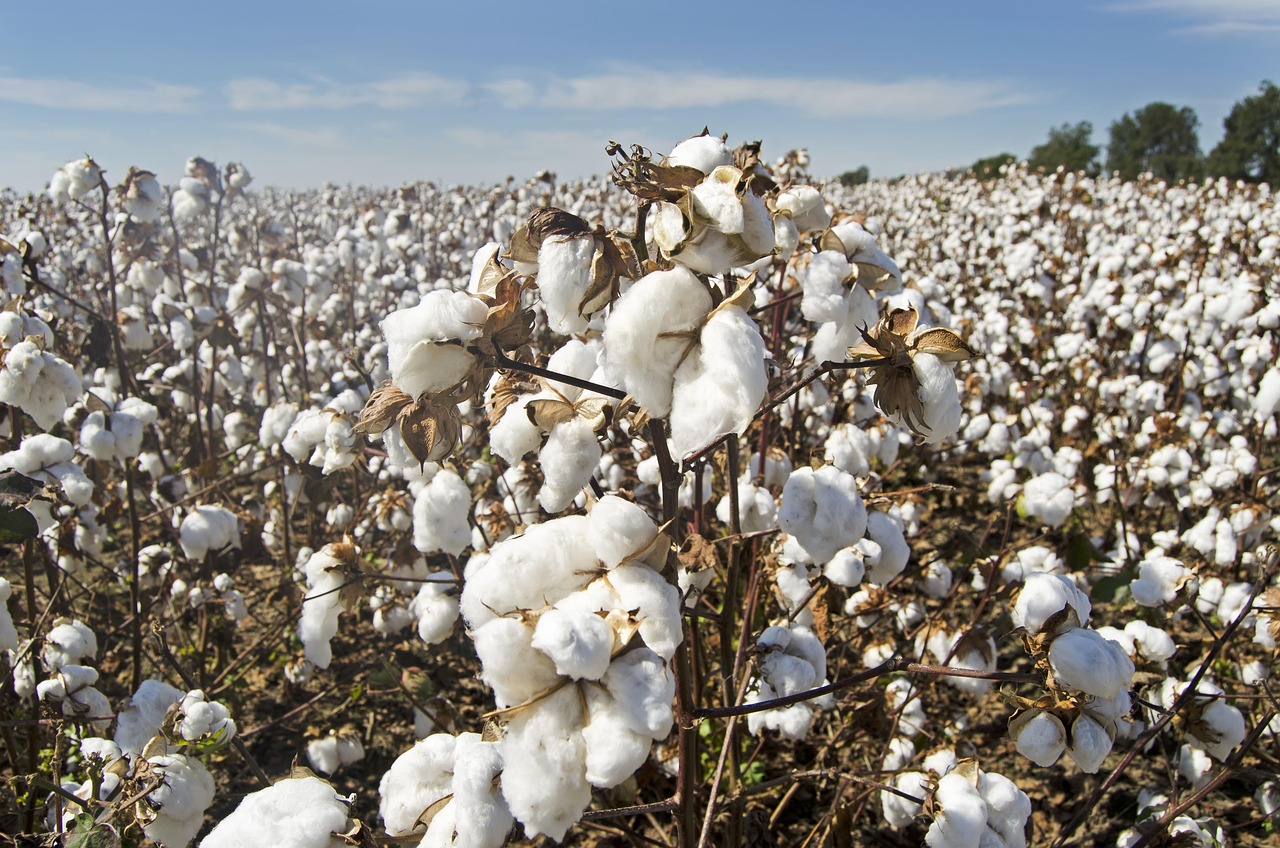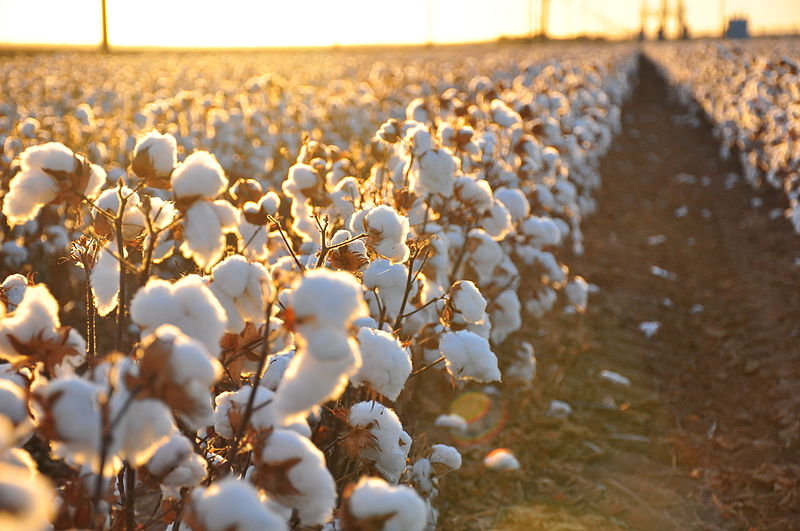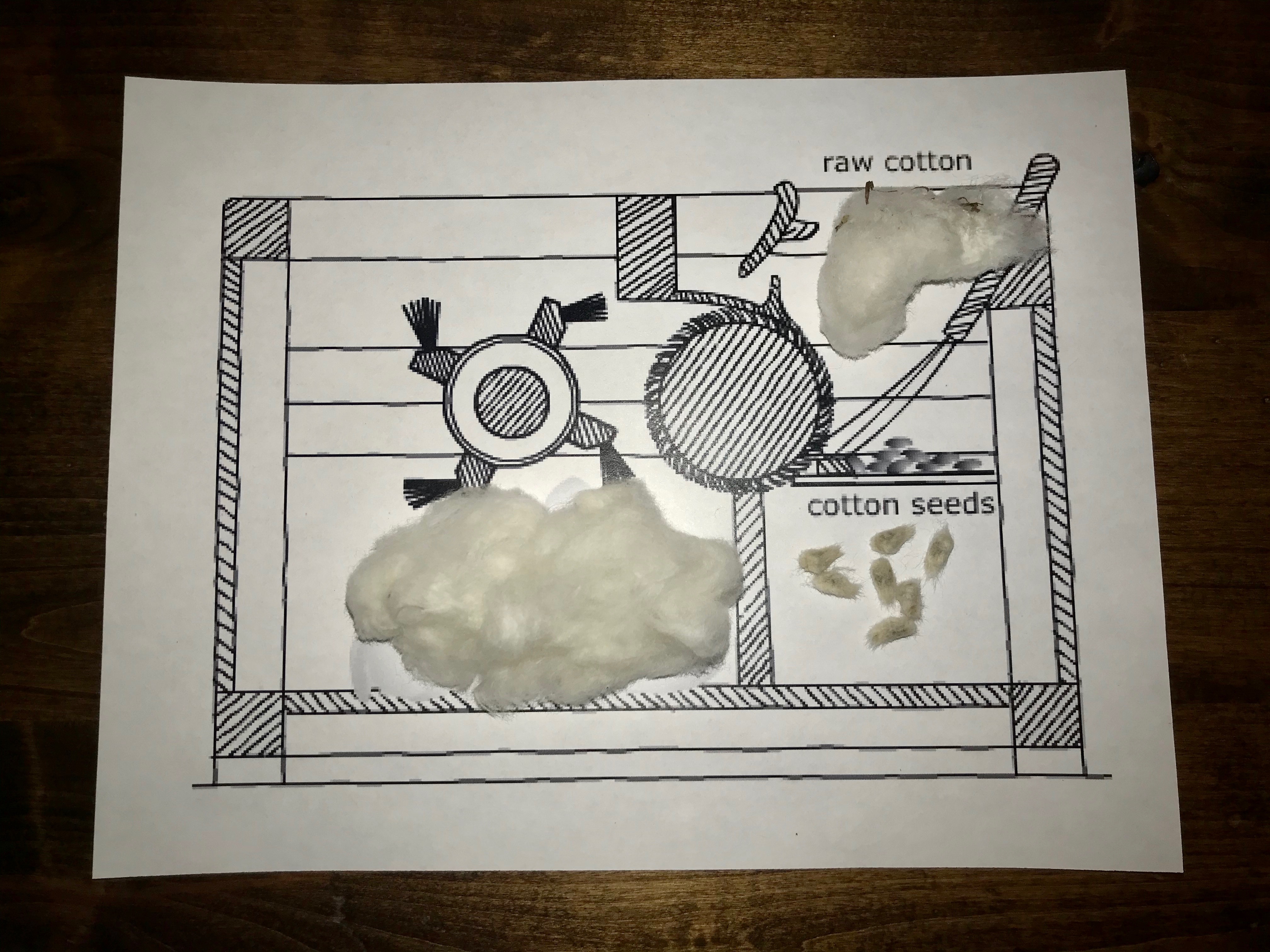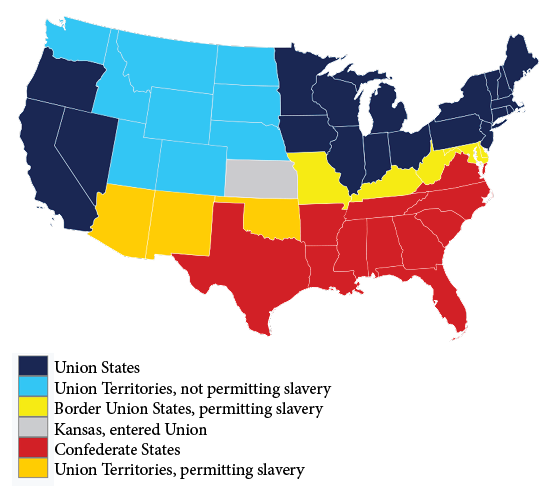Cotton's American Journey (Grades 6-8)
Students investigate the impact of cotton on the history and culture of the United States. Students will discover the growth and processing requirements for cotton, recognize how the invention of the cotton gin affected slavery, explain how the plantation system was organized, and ultimately understand the role of cotton in the Civil War.

Background
Lesson Activities
Recommended Companion Resources
Credits
Author
Debra Spielmaker, Rose Judd-Murray, Lynn Wallin, and Andrea Gardner | Utah Agriculture in the Classroom and National Center for Agricultural Literacy (NCAL)
Acknowledgements
Statistics and graphics from the National Cotton Council's Cotton Counts educational materials.
Paul Smith, Ex-Slave Federal Writer's Project full interview https://www.loc.gov/resource/mesn.043/?sp=325
Sources
- https://www.asanet.org/sites/default/files/savvy/documents/students/docs/FINAL%20C3%20Fact%20Sheet%209-13-13-1.pdf
- https://www.nationalgeographic.org/encyclopedia/plantation-system/
Standards
Texas Content Area Standards
-
Principles of Agriculture, Food, and Natural Resources: 130.2.c.1
The student demonstrates professional standards/employability skills as required by business and industry. The student is expected to:
- Principles of Agriculture, Food, and Natural Resources: 130.2.c.1.B: apply competencies related to resources, information, interpersonal skills, problem solving, critical thinking, and systems of operation in agriculture, food, and natural resources.
-
Principles of Agriculture, Food, and Natural Resources: 130.2.c.4
The student explains the historical, current, and future significance of the agriculture, food, and natural resources industry. The student is expected to:
- Principles of Agriculture, Food, and Natural Resources: 130.2.c.4.B: analyze the scope of agriculture, food, and natural resources and its effect upon society.
- Principles of Agriculture, Food, and Natural Resources: 130.2.c.4.C: evaluate significant historical and current agriculture, food, and natural resources developments.
- Principles of Agriculture, Food, and Natural Resources: 130.2.c.4.E: describe how emerging technologies and globalization impacts agriculture, food, and natural resources.
- Principles of Agriculture, Food, and Natural Resources: 130.2.c.4.F: compare and contrast issues impacting agriculture, food, and natural resources such as biotechnology, employment, safety, environment, and animal welfare issues.
- Principles, of Agriculture, Food, and Natural Resources: 130.2.c.4.D: identify potential future scenarios for agriculture, food, and natural resources systems, including global impacts.
-
Principles of Agriculture, Food, and Natural Resources: 130.2.c.6
The student demonstrates appropriate personal and communication skills. The student is expected to:
- Principles of Agriculture, Food, and Natural Resources: 130.2.c.6.A: demonstrate written and oral communication skills appropriate for formal and informal situations such as prepared and extemporaneous presentations.
- Principles of Agriculture, Food, and Natural Resources: 130.2.c.6.B: demonstrate effective listening skills appropriate for formal and informal situations.
-
Principles of Agriculture, Food, and Natural Resources: 130.2.c.7
The student applies appropriate research methods to agriculture, food, and natural resources topics. The student is expected to:
- Principles of Agriculture, Food, and Natural Resources: 130.2.c.7.B: use a variety of resources for research and development.
- Principles of Agriculture, Food, and Natural Resources: 130.2.c.7.C: describe scientific methods of research.
- Principles of Agricultures, Food, and Natural Resources: 130.2.c.7.A: discuss major research and developments in the fields of agriculture, food, and natural resources.
-
Principles of Agriculture, Food, and Natural Resources: 130.2.c.11
The student develops technical knowledge and skills related to plant systems. The student is expected to:
- Principles of Agriculture, Food, and Natural Resources: 130.2.c.11.D: identify plants of importance to agriculture, food, and natural resources
-
Social Studies: 6.113.18.c.8
Economics. The student understands categories of economic activities and the data used to measure a society's economic level. The student is expected to:
- Social Studies: 6.113.18.c.8.A: define and give examples of agricultural, retail, manufacturing (goods), and service industries
-
Social Studies: 7.113.19.c.12
Economics. The student understands the interdependence of the Texas economy with the United States and the world. The student is expected to:
- Social Studies: 7.113.19.c.12.A: explain the impact of national and international markets on the production of goods and services in Texas, including agriculture and oil and gas
-
Social Studies: 8.113.20.c.12
Economics. The student understands why various sections of the United States developed different patterns of economic activity through 1877. The student is expected to:
- Social Studies: 8.113.20.c.12.B: explain reasons for the development of the plantation system, the transatlantic slave trade, and the spread of slavery;
-
ELA: 8.110.24.b.1
Developing and sustaining foundational language skills: listening, speaking, discussion, and thinking- oral language. The student develops oral language through listening, speaking, and discussion.
- ELA: 8.110.24.b.1.B: follow and give complex oral instructions to perform specific tasks, answer questions, or solve problems
-
Social Studies: 6.113.18.c.19
Social studies skills. The student applies critical-thinking skills to organize and use information acquired through established research methodologies from a variety of valid sources, including technology. The student is expected to:
- Social Studies: 6.113.18.c.19.C: organize and interpret information from outlines, reports, databases, and visuals, including graphs, charts, timelines, and maps
-
Social Studies: 6.113.18.c.21
Social studies skills. The student communicates in written, oral, and visual forms. The student is expected to:
- Social Studies: 6.113.18.c.21.C: express ideas orally based on research and experiences
-
Social Studies: 6.113.18.c.22
Social studies skills. The student uses problem-solving and decision-making skills, working independently and with others. The student is expected to:
- Social Studies: 6.113.18.c.22.B: use problem-solving and decision-making processes to identify a problem, gather information, list and consider options, consider advantages and disadvantages, choose and implement a solution, and evaluate the effectiveness of the solution
-
Social Studies: 7.113.19.c.5
History. The student understands how events and issues shaped the history of Texas during the Civil War and Reconstruction. The student is expected to:
- Social Studies: 7.113.19.c.5.A: explain the central role the expansion of slavery played in the involvement of Texas in the Civil War
-
Science: 6.112.26.b.4
Scientific and engineering practices. The student knows the contributions of scientists and recognizes the importance of scientific research and innovation on society. The student is expected to:
- Science: 6.112.26.b.4.A: relate the impact of past and current research on scientific thought and society, including the process of science, cost-benefit analysis, and contributions of diverse scientists as related to the content;
- Science: 6.112.26.b.4.B: make informed decisions by evaluating evidence from multiple appropriate sources to assess the credibility, accuracy, cost-effectiveness, and methods used; and
- Science: 6.112.26.b.4.C: research and explore resources such as museums, libraries, professional organizations, private companies, online platforms, and mentors employed in a science, technology, engineering, and mathematics (STEM) field to investigate STEM careers.
-
Social Studies: 7.113.19.c.20
Social studies skills. The student applies critical-thinking skills to organize and use information acquired through established research methodologies from a variety of valid sources, including technology. The student is expected to:
- Social Studies: 7.113.19.c.20.C: organize and interpret information from outlines, reports, databases, and visuals, including graphs, charts, timelines, and maps
- Social Studies: 7.113.19.c.20.E: formulate and communicate visually, orally, or in writing a claim supported by evidence and reasoning related to a social studies topic
-
Social Studies: 7.113.19.c.23
Social studies skills. The student uses problem-solving and decision-making skills, working independently and with others. The student is expected to:
- Social Studies: 7.113.19.c.23.B: use problem-solving and decision-making processes to identify a problem, gather information, list and consider options, consider advantages and disadvantages, choose and implement a solution, and evaluate the effectiveness of the solution
-
Social Studies: 8.113.20.c.7
History. The student understands how political, economic, and social factors led to the growth of sectionalism and the Civil War. The student is expected to:
- Social Studies: 8.113.20.c.7.D: analyze the impact of slavery on different sections of the United States
-
Social Studies: 8.113.20.c.8
History. The student understands individuals, issues, and events of the Civil War. The student is expected to:
- Social Studies: 8.113.20.c.8.B: explain the central role of the expansion of slavery in causing sectionalism, disagreement over states' rights, and the Civil War
-
Social Studies: 8.113.20.c.27
Science, technology, and society. The student understands the impact of science and technology on the economic development of the United States. The student is expected to:
- Social Studies: 8.113.20.c.27.A: explain the effects of technological and scientific innovations such as the steamboat, the cotton gin, the telegraph, and interchangeable parts
-
Social Studies: 8.113.20.c.29
Social studies skills. The student applies critical-thinking skills to organize and use information acquired through established research methodologies from a variety of valid sources, including technology. The student is expected to:
- Social Studies: 8.113.20.c.29.C: organize and interpret information from outlines, reports, databases, and visuals, including graphs, charts, timelines, and maps
- Social Studies: 8.113.20.c.29.E: formulate and communicate visually, orally, or in writing a claim supported by evidence and reasoning related to a social studies topic
-
Social Studies: 8.113.20.c.31
Social studies skills. The student uses problem-solving and decision-making skills, working independently and with others. The student is expected to:
- Social Studies: 8.113.20.c.31.B: use problem-solving and decision-making processes to identify a problem, gather information, list and consider options, consider advantages and disadvantages, choose and implement a solution, and evaluate the effectiveness of the solution
-
Science: 7.112.27.b.4
Scientific and engineering practices. The student knows the contributions of scientists and recognizes the importance of scientific research and innovation on society. The student is expected to:
- Science: 7.112.27.b.4.A: relate the impact of past and current research on scientific thought and society, including the process of science, cost-benefit analysis, and contributions of diverse scientists as related to the content;
- Science: 7.112.27.b.4.B: make informed decisions by evaluating evidence from multiple appropriate sources to assess the credibility, accuracy, cost-effectiveness, and methods used; and
- Science: 7.112.27.b.4.C: research and explore resources such as museums, libraries, professional organizations, private companies, online platforms, and mentors employed in a science, technology, engineering, and mathematics (STEM) field to investigate STEM careers
-
Science: 8.112.28.b.4
Scientific and engineering practices. The student knows the contributions of scientists and recognizes the importance of scientific research and innovation on society. The student is expected to
- Science: 8.112.28.b.4.A: relate the impact of past and current research on scientific thought and society, including the process of science, cost-benefit analysis, and contributions of diverse scientists as related to the content;
- Science: 8.112.28.b.4.B: make informed decisions by evaluating evidence from multiple appropriate sources to assess the credibility, accuracy, cost-effectiveness, and methods used; and
- Science: 8.112.28.b.4.C: research and explore resources such as museums, libraries, professional organizations, private companies, online platforms, and mentors employed in a science, technology, engineering, and mathematics (STEM) field to investigate STEM careers.
-
ELA: 6.110.22.b.1
Developing and sustaining foundational language skills: listening, speaking, discussion, and thinking--oral language. The student develops oral language through listening, speaking, and discussion. The student is expected to:
- ELA: 6.110.22.b.1.B: follow and give oral instructions that include multiple action steps
- ELA: 6.110.22.b.1.C: give an organized presentation with a specific stance and position, employing eye contact, speaking rate, volume, enunciation, natural gestures, and conventions of language to communicate ideas effectively
- ELA: 6.110.22.b.1.D: participate in student-led discussions by eliciting and considering suggestions from other group members, taking notes, and identifying points of agreement and disagreement.
-
ELA: 6.110.22.b.12
Inquiry and research: listening, speaking, reading, writing, and thinking using multiple texts. The student engages in both short-term and sustained recursive inquiry processes for a variety of purposes. The student is expected to:
- ELA: 6.110.22.b.12.A: generate student-selected and teacher-guided questions for formal and informal inquiry
- ELA: 6.110.22.b.12.D: identify and gather relevant information from a variety of sources
- ELA: 6.110.22.b.12.F: synthesize information from a variety of sources
- ELA: 6.110.22.b.12.J: use an appropriate mode of delivery, whether written, oral, or multimodal, to present results
-
ELA: 7.110.23.b.1
Developing and sustaining foundational language skills: listening, speaking, discussion, and thinking--oral language. The student develops oral language through listening, speaking, and discussion. The student is expected to:
- ELA: 7.110.23.b.1.B: follow and give complex oral instructions to perform specific tasks, answer questions, or solve problems
- ELA: 7.110.23.b.1.D: engage in meaningful discourse and provide and accept constructive feedback from others
-
ELA: 7.110.23.b.12
Inquiry and research: listening, speaking, reading, writing, and thinking using multiple texts. The student engages in both short-term and sustained recursive inquiry processes for a variety of purposes. The student is expected to:
- ELA: 7.110.23.b.12.A: generate student-selected and teacher-guided questions for formal and informal inquiry
- ELA: 7.110.23.b.12.D: identify and gather relevant information from a variety of sources
- ELA: 7.110.23.b.12.F: synthesize information from a variety of sources
- ELA: 7.110.23.b.12.J: use an appropriate mode of delivery, whether written, oral, or multimodal, to present results
-
ELA: 8.110.24.b.12
Inquiry and research: listening, speaking, reading, writing, and thinking using multiple texts. The student engages in both short-term and sustained recursive inquiry processes for a variety of purposes. The student is expected to:
- ELA: 8.110.24.b.12.A: generate student-selected and teacher-guided questions for formal and informal inquiry
- ELA: 8.110.24.b.12.D: identify and gather relevant information from a variety of sources
- ELA: 8.110.24.b.12.F: synthesize information from a variety of sources
- ELA: 8.110.24.b.12.J: use an appropriate mode of delivery, whether written, oral, or multimodal, to present results


